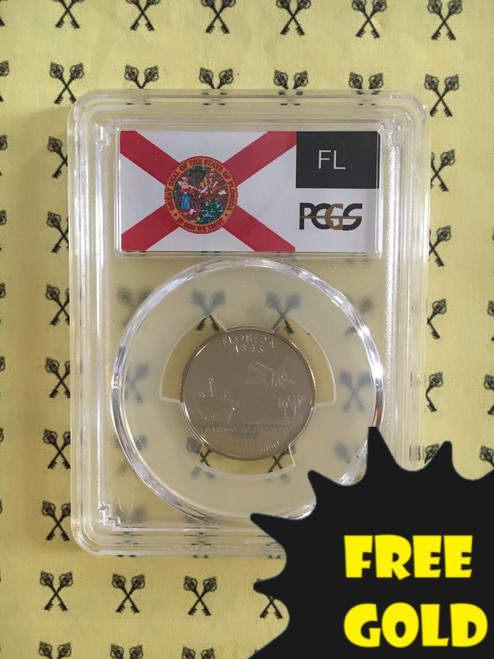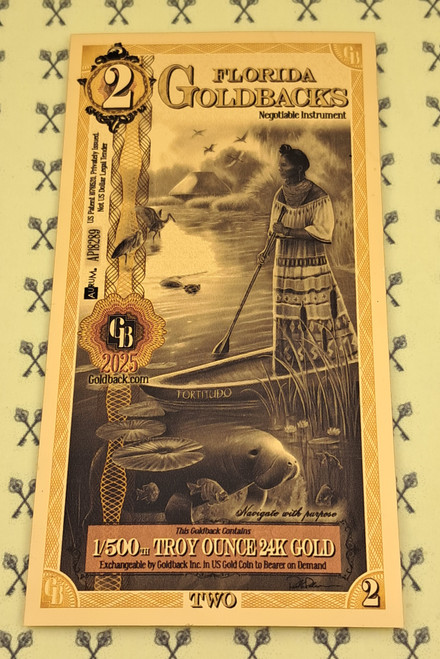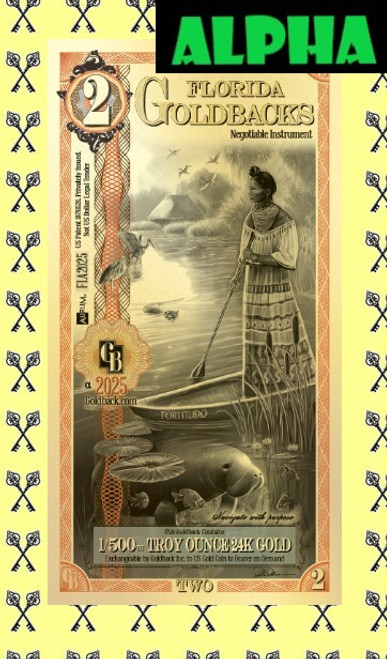Florida
Will Florida be the first state to get a Quarter Goldback?

Florida Quarter (1/4) Goldback Concept. Click the image to see why there should be a 0.25 Goldback.
Where to buy Goldbacks in Florida
Save on shipping by supporting your local Florida Goldback dealers.
- Miami Gold Coins, Inc
13789 S Dixie Hwy
Miami FL 33176
Phone: +1 (786) 242-3700
Want Your Business Listed?
Do you accept, buy or sell Goldbacks in Florida? Contact us to be featured on this page and help more people find your store.
Why the 2025 Florida House Bill 999 Is Significant for Goldbacks
Florida House Bill 999 (H.B. 999), passed in 2025, marks a pivotal moment for the use of gold and silver as legal tender in the state. This legislation, which recognizes gold and silver coins as valid forms of payment for debts, taxes, and fees, has significant implications for Goldbacks, a voluntary medium of exchange made from fractions of an ounce of physical gold. Below, we explore why H.B. 999 is a game-changer for Goldbacks and its potential impact on Florida’s economy and beyond.
What Is H.B. 999?
Sponsored by Representatives Doug Bankson and Monique Miller, H.B. 999 establishes gold and silver coins as legal tender in Florida for the payment of debts, public charges, taxes, or dues. The bill defines “specie” as coins minted from refined gold or silver, valued primarily for their metal content, with at least 99.5 percent purity. It also allows state agencies and political subdivisions to accept gold or silver payments via electronic transfer, provided they have the regulatory authority and technical capability to do so.
The bill passed unanimously in the Florida Senate (38-0) on April 29, 2025, and in the House (113-0) on April 30, 2025, reflecting broad bipartisan support. It is now awaiting the governor’s signature to become law.
Goldbacks: A Unique Form of Currency
Goldbacks are notes crafted from thin layers of pure gold, designed to be a spendable form of physical gold for small transactions. Unlike traditional gold coins or bars, Goldbacks are lightweight, durable, and denominated in small fractions of an ounce, making them practical for everyday use. They are a voluntary, local medium of exchange, meaning their use depends on mutual agreement between parties.
Goldbacks have gained traction in states like New Hampshire, where a favorable tax climate and public willingness to embrace alternative currencies have fostered a thriving gold and silver economy. H.B. 999 positions Florida to follow a similar path by creating a legal framework that supports the use of gold-based currencies like Goldbacks.
Key Impacts of H.B. 999 on Goldbacks
- Legal Recognition as Tender: By recognizing gold coins as legal tender, H.B. 999 provides a legal basis for using Goldbacks in transactions where both parties agree. This recognition enhances the credibility and usability of Goldbacks, potentially increasing their acceptance among businesses and individuals.
- Tax Advantages: The bill repeals state taxes on the exchange of gold and silver, removing a significant barrier to using Goldbacks. In states like New Hampshire, the absence of such taxes has encouraged widespread use of precious metals in private transactions. Florida’s tax repeal could similarly incentivize residents to adopt Goldbacks for everyday purchases.
- Contract Clause Protections: H.B. 999 includes provisions that protect contracts specifying payment in gold or silver. If parties agree to use Goldbacks in a transaction, Florida courts cannot substitute another form of payment. This legal protection ensures that Goldback transactions are enforceable, boosting confidence in their use.
- Competition with Fiat Currency: By recognizing gold and silver as legal tender, H.B. 999 introduces competition to the Federal Reserve’s fiat currency system. Goldbacks, as a tangible, gold-backed currency, offer an alternative to paper money, which could appeal to those seeking to hedge against inflation or currency devaluation.
- Support for Sound Money: The bill aligns with the broader “sound money” movement, which advocates for currencies backed by intrinsic value, such as gold. Goldbacks, with their physical gold content, embody this principle, and H.B. 999’s passage could inspire other states to adopt similar measures, expanding the market for Goldbacks nationwide.
Broader Implications for Florida’s Economy
The passage of H.B. 999 could position Florida as a leader in the sound money movement, following states like Utah, Wyoming, and Idaho, which have already recognized gold and silver as legal tender. By facilitating the use of Goldbacks and other precious metal currencies, Florida may attract businesses and individuals who value alternative monetary systems. This could stimulate local economies, particularly in sectors like retail and small business, where Goldbacks are well-suited for small transactions.
Moreover, the bill’s unanimous passage signals strong political support for innovative financial policies. If signed into law, Florida would become the eighth state to recognize gold and silver as legal tender, potentially setting a precedent for other states to follow. This could create a ripple effect, increasing demand for Goldbacks and similar currencies across the country.
Challenges and Considerations
While H.B. 999 is a significant step forward, challenges remain. The bill specifies that no one can be compelled to accept gold or silver as payment unless agreed upon by contract, which means Goldbacks’ success depends on voluntary adoption. Public awareness and education about Goldbacks will be crucial to their widespread use. Additionally, businesses may need to invest in infrastructure to process gold-based payments, which could pose a barrier for some.
Another consideration is the regulatory framework for custodians of gold and silver, as outlined in the bill. Custodians holding public deposits must meet specific requirements, and the Office of Financial Regulation (OFR) must approve their applications. While these measures ensure accountability, they could create administrative hurdles for entities handling Goldbacks.
Conclusion
Florida H.B. 999 represents a landmark achievement for advocates of gold-backed currencies like Goldbacks. By recognizing gold and silver as legal tender, repealing taxes on their exchange, and protecting gold-based contracts, the bill creates a favorable environment for Goldbacks to thrive. As Florida joins the ranks of states embracing sound money, the potential for Goldbacks to become a viable alternative currency grows, offering residents a hedge against economic uncertainty and a means to participate in a decentralized monetary system.
The success of Goldbacks in Florida will depend on public adoption and the state’s ability to implement the bill’s provisions effectively. If signed into law, H.B. 999 could pave the way for a new era of financial innovation, with Goldbacks at the forefront of this transformation.
Sources
Florida is the first large state to get Goldbacks
The first five states to get Goldbacks have been smaller states. Goldback has made a bold move and in 2025, Florida was the first large state to use Goldbacks. Florida Goldback series is accepted at these FL locations. The CEO of Goldback, Jeremy Cordon, is so series about the success in Florida that he has moved to Florida.
Florida was chosen for several reasons:
- In 2024, Florida was the 10th best state in the Sound Money Index and all 5 of the current Goldback states are in the top 12 Sound Money Index.
- On January 9th 2024, bills are introduced in the Florida legislature to allow gold and silver to be used as legal tender.
All the artwork for the Florida series was hand-drawn by Paul Pederson.</p
History of Gold in Florida
Florida may not be the first state that comes to mind when discussing gold, but its history is surprisingly rich with golden intrigue—especially along its coasts and in its connection to shipwrecks, hidden treasure, and colonial ambitions.
Spanish Treasure Fleets
The most captivating chapter of Florida’s gold history begins during the Spanish colonial period. In the 16th and 17th centuries, Spanish galleons carrying gold and silver from the New World back to Spain often sailed along the Florida coastline. These fleets—known as the Spanish Treasure Fleets—were loaded with precious metals, gemstones, and artifacts collected from Central and South America.
In 1715, one such fleet was struck by a hurricane off the coast of what is now known as Florida's Treasure Coast, near present-day Vero Beach. Eleven of the twelve ships sank, spilling countless gold coins and valuable cargo into the sea. This event led to centuries of treasure hunting and remains a legendary part of Florida’s gold lore.
Treasure Hunting and Salvage
To this day, Florida is home to ongoing salvage operations and treasure hunters who continue to recover gold from historic shipwrecks. Notable figures like Mel Fisher became famous for recovering millions in treasure, including gold bars and coins, from wrecks like the Nuestra Señora de Atocha off the Florida Keys.
Florida law and federal regulations now provide some protections and guidelines for treasure salvaging, but the fascination with lost gold remains strong. Numerous museums across the state display artifacts recovered from Florida waters.
Gold in Modern Florida
Although there are no natural gold veins or major mining operations in Florida, the state’s contribution to America’s gold heritage is centered on its maritime history and its role in preserving and uncovering the riches of the past.
Gold has also played a symbolic and economic role in Florida’s development—attracting adventurers, investors, and tourists alike, all drawn by the state’s reputation for sunshine and the lingering mystery of sunken treasure.
In Florida, gold isn’t mined from the mountains—it’s found beneath the waves and written into the tide of history.











